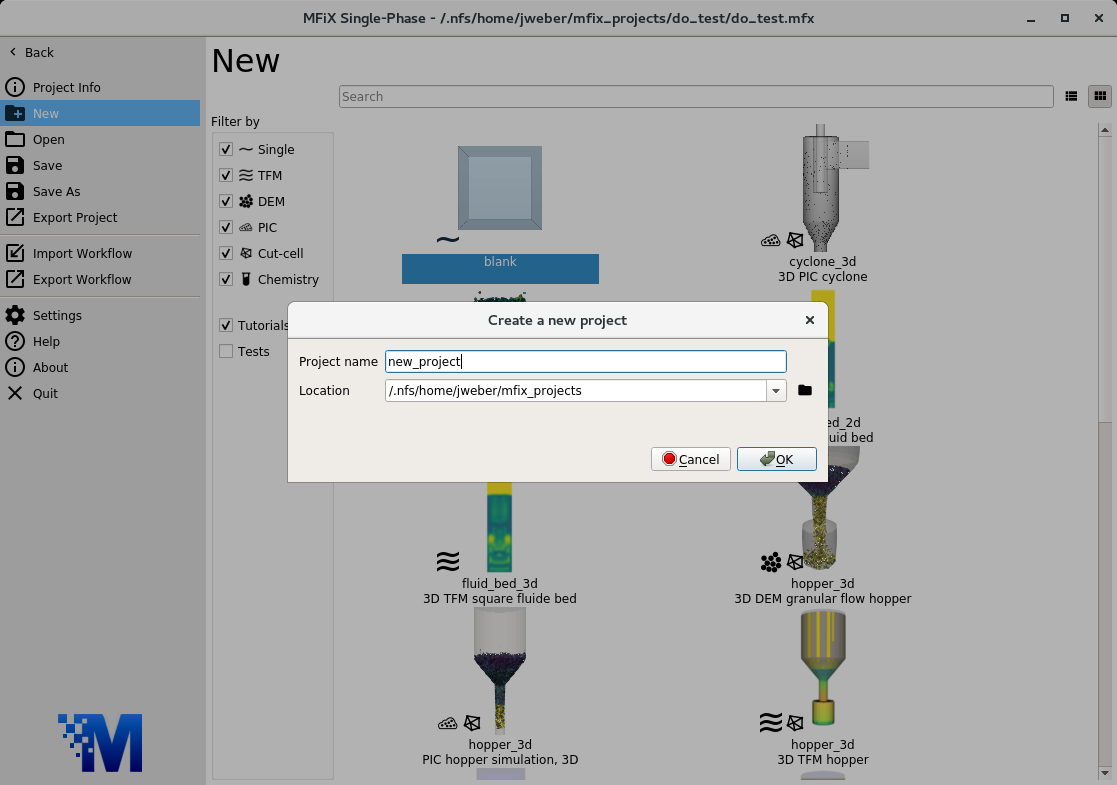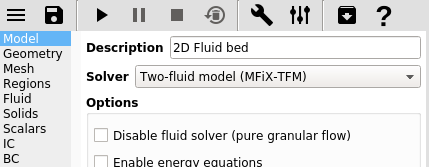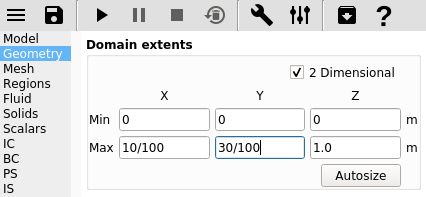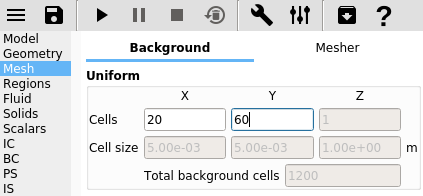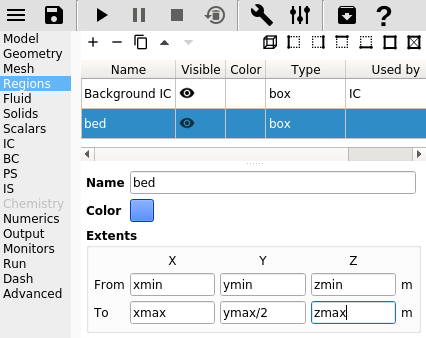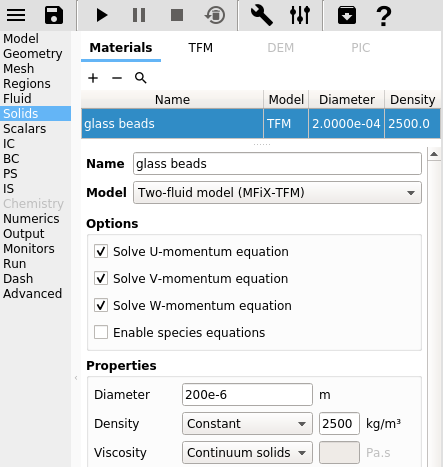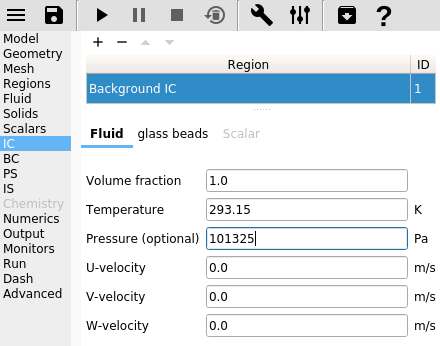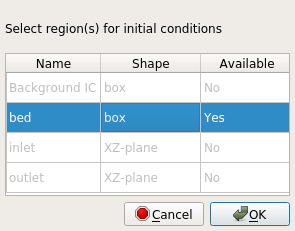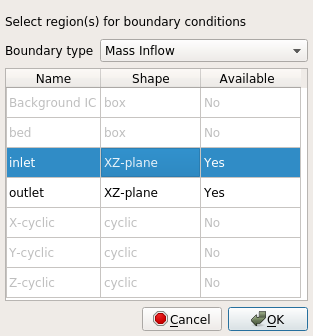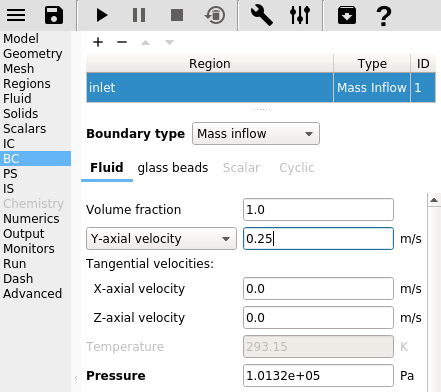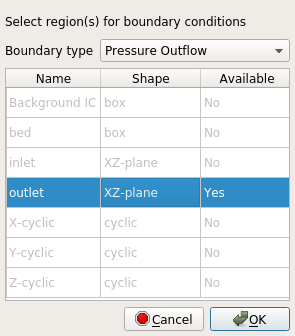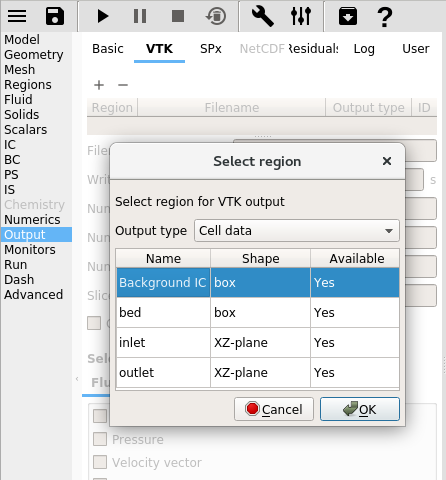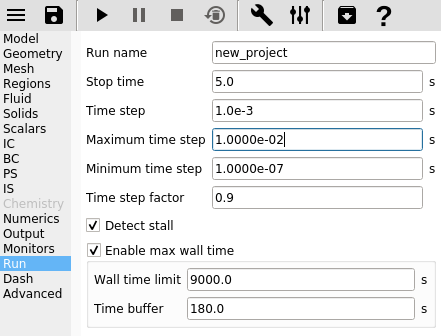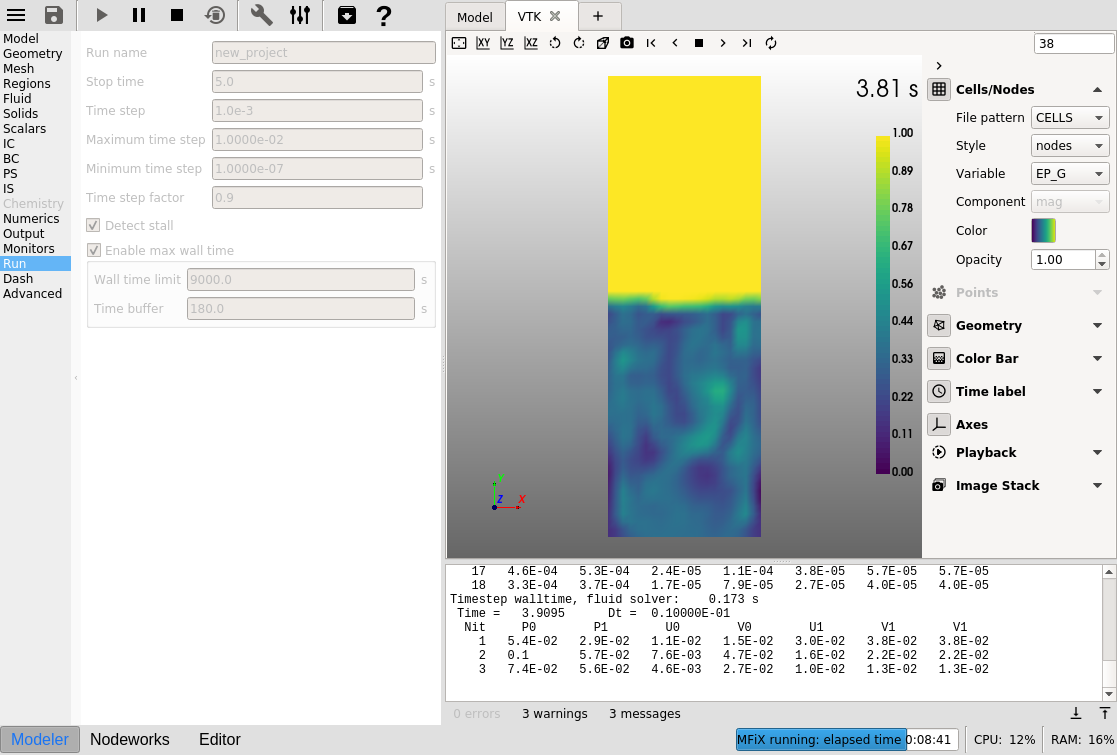3.2. Two-dimensional fluidized bed, Two-fluid Model (TFM)¶
This tutorial shows how to create a two dimensional fluidized bed simulation using the two-fluid model. The model setup is:
Property |
Value |
|---|---|
Geometry |
10 cm x 30 cm |
Mesh |
20 x 60 |
Solid diameter |
200 microns (\(200 \times 10^{-6}\) m) |
Solid density |
2500 kg/m2 |
Gas velocity |
0.25 m/s |
Temperature |
298 K |
Pressure |
101325 Pa |
3.2.1. Create a new project¶
On the main menu select
New projectCreate a new project by double-clicking on “Blank” template.
Enter a project name and browse to a location for the new project.
When prompted to enable SMS workflow, answer No, we will use the standard workflow for this tutorial.
Note
A new project directory will be created in the location directory, with the name being the project name.
3.2.2. Select model parameters¶
On the Model pane:
Enter a descriptive text in the
DescriptionfieldSelect “Two-Fluid Model (MFiX-TFM)” in the
Solverdrop-down menu.
3.2.3. Enter the geometry¶
On the Geometry pane:
Select the
2 DimensionalcheckboxEnter
10/100meters for the maximum x valueEnter
30/100meters for the maximum y value
Note
We could have entered 0.1 and 0.3 to define the domain extents, but this example shows that simple mathematical expressions (+,-,*,/) are allowed.
3.2.4. Enter the mesh¶
On the Mesh pane, Background sub-pane:
Enter
20for the x cell valueEnter
60for the y cell value
3.2.5. Create regions for initial and boundary condition specification¶
Select the Regions pane. By default, a region that covers the entire domain
is already defined. This is typically used to initialize the flow field and
visualize the results.
Click the
(add) button to create a new region to be used for the bed initial condition.
Enter a name for the region in the
Namefield (“bed”)Change the color by pressing the
ColorbuttonEnter
xminorminin theFrom XfieldEnter
xmaxormaxin theTo XfieldEnter
yminorminin theFrom YfieldEnter
ymax/2ormax/2in theTo YfieldEnter
zminorminin theFrom ZfieldEnter
zmaxormaxin theTo Zfield
Note
Here we could have entered numerical values for the coordinates, but it is recommended to use parameters (xmin, xmax etc.) when possible. These parameters will update automatically if the “Domain Extents” change.
Click the
(bottom) button to create a new region with the
FromandTofields already filled out for a region at the bottom of the domain, to be used by the gas inlet boundary condition.From YandTo Yshould equalymin, defining an XZ-plane.Enter a name for the region in the
Namefield (“inlet”)
Click the
(top) button to create a new region with the
FromandTofields already filled out for a region at the top of the domain, to be used by the pressure outlet boundary condition.From YandTo Yshould equalymax, defining an XZ-plane.Enter a name for the region in the
Namefield (“outlet”)
3.2.6. Create a solid¶
On the Solids pane:
Click the
button to create a new solid
Accept the radial distribution setting (Carnahan-Starling)
Enter a descriptive name in the
Namefield (“glass beads”)Keep the model as “Two-Fluid Model (MFiX-TFM)”)
Enter the particle diameter of
200e-6m in theDiameterfieldEnter the particle density of
2500kg/m2 in theDensityfield
3.2.7. Create Initial Conditions¶
On the Initial conditions pane:
Select the already populated “Background IC” from the region list. This will initialize the entire flow field with air.
Enter
101325Pa in thePressure (optional)field
Create a new Initial Condition by pressing the
button
Select the bed region created previously for the bed Initial Condition (“bed” region) and click the
OKbutton.
Select the solid (named previously as “glass beads”) sub-pane and enter a volume fraction of
0.4in theVolume Fractionfield. This will fill the bottom half of the domain with glass beads.
3.2.8. Create Boundary Conditions¶
On the Boundary conditions pane:
Create a new Boundary condition by clicking the
button
On the
Select regiondialog, select “Mass Inflow” from theBoundary typedrop-down menuSelect the “inlet” region and click
OK
On the “Fluid” sub-pane, enter a velocity in the
Y-axial velocityfield of “0.25” m/s
Create another Boundary condition by clicking the
button
On the
Select regiondialog, select “Pressure outflow” from theBoundary typecombo-boxSelect the “outlet” region and click
OK
Note
The default pressure is already set to 101325 Pa, no changes need to be made to the outlet boundary condition.
Note
By default, boundaries that are left undefined (here the left and right planes) will behave as No-Slip walls.
3.2.9. Change numeric parameters¶
On the Numerics pane, Residuals sub-pane:
Enter
0in theFluid Normalizationfield.
3.2.10. Select output options¶
On the Output pane:
On the
Basicsub-pane, check theWrite VTK output files (VTU/VTP)checkbox
Select the
VTKsub-paneCreate a new output by clicking the
button
Select the “Background IC” region from the list to save all the cell data
Click
OKto create the output
Enter a base name for the
*.vtufiles in theFilename basefieldChange the
Write intervalto0.1secondsSelect the
Volume fraction,Pressure, andVelocity vectorcheckboxes on theFluidsub-sub-pane
3.2.11. Change run parameters¶
On the Run pane:
Change the
Time stepto1e-3secondsChange the
Maximum time stepto1e-2seconds
3.2.12. Run the project¶
Save project by clicking the
button
Run the project by clicking the
button
On the
Run Solverdialog, select the executable from the combo-boxClick the
Runbutton to actually start the simulation
3.2.13. View results¶
Results can be viewed, and plotted, while the simulation is running.
Create a new visualization tab by pressing the
next to the Model tab
Select an item to view, such as plotting the time step (dt) or click the
3D viewbutton to view the vtk output files.
On the
VTKresults tab, the visibility and representation of the*.vtkfiles can be controlled with the menu on the side.
Change frames with the
,
,
, and
buttons
Click the
button to play the available vtk files.
Change the playback speed under the
section on the sidebar.
3.2.14. Increase grid resolution¶
For this simulation, increasing the grid resolution will better resolve the bubbles (at the expense of a slower simulation time). To do this:
Click the
button and delete all simulation files.
On the
Meshpane, change theX Cellsto 80 and theY Cellsto 180On the
Outputpane,VTKsub-pane, change the write interval to0.01Save and run the project.
